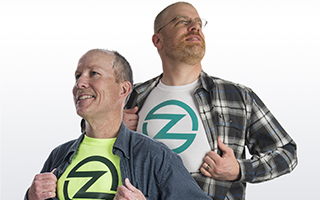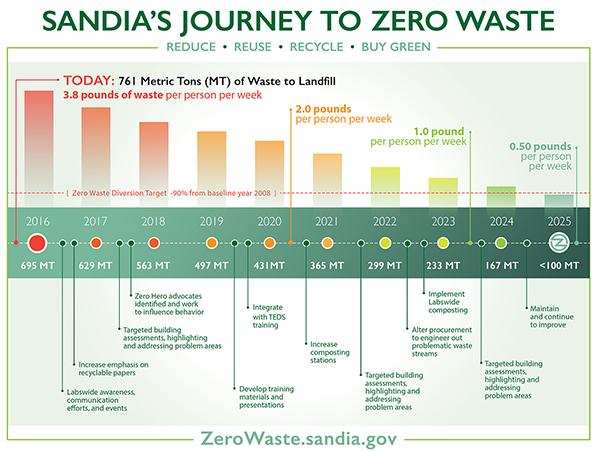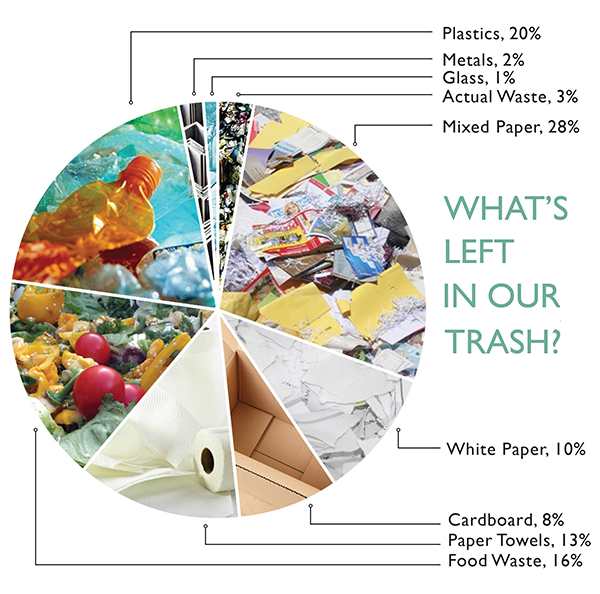
It’s hard to miss the kiosks prominently displayed at turnstiles and in lobbies around Sandia: a Zero Hero proudly displaying the “Z” emblem through a neatly pressed business shirt and tie. He represents the power each person has to reduce waste at Sandia — thus becoming a Zero Hero — and is part of a newly launched Zero Waste campaign by Sandia’s Materials Sustainability and Pollution Prevention (MSP2) program.
In 2008, the MSP2 program set a goal of making the Labs a Zero Waste facility by 2025. The initiative applies only to non-hazardous solid waste, which is typical office waste, and covers the life cycle of materials from the purchase, use, and final disposal of items.
The goal uses the US Zero Waste Business Council performance metric that defines businesses and communities as successfully achieving zero waste when it realizes more than a 90 percent diversion of waste from landfills and incinerators. Methane gas is generated as waste decomposes. Landfills are the third-largest source of methane emissions in the United States, according to a 24-year emissions inventory report published by the US Environmental Protection Agency in 2016, and, in 2013, accounted for about 10 percent of all US greenhouse gas emissions.

Clean city, clean site
“At the time we chose our goal of zero waste by 2025, the city of Albuquerque had set a goal of zero waste to the landfill by 2030,” says MSP2 program coordinator Ralph Wrons (4144). “This is when we updated our program’s vision statement to include that Zero Waste promotes and integrates materials sustainability into all Sandia operations. Since Sandia hauls all of its office trash to the city of Albuquerque landfill, our goal, in turn, assists the city in reaching its goal. We also use several local recycling vendors and one compost facility operator for the diversion of our waste.”
It’s not just about fostering a waste-conscious community; it’s about impacting DOE sites across the board.
“Coincidently, this past year DOE updated its annual Strategic Sustainability Performance Plan, which followed up on a presidential executive order, and it outlined some net zero goals in terms of energy, water, and waste. There are different goals for the federal government by 2025 but it turns out we are right in line with the zero waste goals. When we established the goal for the New Mexico site, we were definitely ahead of DOE and what they were indicating at the time,” says Ralph. By establishing a Zero Waste program prior to the release of DOE’s plan, Ralph says Sandia is able to identify best practices for waste diversion and share that information with other NNSA sites that may be just starting programs.
“Setting a goal and striving for zero waste is in line with Sandia’s commitment to service and to shaping a waste-free future by setting the standard and leading by example,” says Div. 4000 VP Michael Hazen.
Sizeable solids
Between 2009 and 2012, the MSP2 program made improvements to existing recycle streams and added multiple others, added compost collection points in the cafeterias, and introduced zero waste events at catered functions, such as Take Our Daughters and Sons to Work Day/Earth Day. Team members also attended workshops to learn more about zero waste concepts and how to implement them.
After reaching a plateau in diversion in 2014, the MSP2 program began work on its own strategic plan to understand current types and trends of waste across the Labs and how members of the workforce can compost, reduce, reuse, or recycle those materials to divert waste from a landfill.

Sandia’s baseline is 1,048 metric tons of waste, the amount of waste sent to the landfill in fiscal year 2008. In 2015, 761 metric tons of waste were generated, down 27 percent from 2008 and staying on schedule for a zero waste 2025 goal of 90 percent reduction. In 2015, members of the workforce reused, recycled, or composted 67 percent of the potential non-hazardous solid waste destined for the landfill, says Sam McCord (4144), an environmental technical planner. Members of the workforce currently average 3.8 pounds of waste per week per person. The goal is to reduce that average to 2 pounds per week by 2020 and to 1 pound per person per week by 2023.
“If Sandia is able to achieve a 90 percent or higher reduction rate by 2025 — determined from the baseline numbers in 2008 — we’ll be at one-half of a pound of waste per person per week,” Sam says.
Based on multiple waste assessments conducted in 2015 by the MSP2 program, with help from Custodial Services, 59 percent of Sandia’s solid waste was paper — 28 percent mixed paper, 13 percent paper towels, 10 percent white paper, and 8 percent cardboard. “That’s close to 1 million pounds of paper, whether junk mail, microwave lunch boxes, copy paper, boxes, or bathroom paper towels,” says Sam. Aside from composting bathroom paper towels, an option currently only available to 10 percent of the workforce based on their building location outside of the limited areas, members of the workforce have a direct impact on what does and doesn’t make it in recycling bins.
Recent EPA data suggests that recycling 1 ton of paper would:
- Save the energy equivalent of 165 gallons of gasoline
- Save enough energy to power the average American home for six months
- Save 7,000 gallons of water
- Save 3.3 cubic yards of landfill space

A partnership among organizations
The MSP2 program has worked with numerous organizations to make the zero waste goal possible. Volunteers assisted in collecting recyclables, auditing waste around the campus, and making employees aware of the impacts they have on reducing, reusing, recycling, and buying green, Ralph says.
In addition to volunteers, members of Custodial Services have become a vital part of Sandia’s recycling efforts.
“The custodial department agreed to pilot having custodians manage mixed paper inside buildings and moving it to dumpsters located outside. This was previously done by volunteers but the custodial support makes the process routine and efficient,” says Sam.
Recycling as a last option
Reducing waste is actually the first — and cheapest — way the workforce can help, says Sam. Sandia is migrating away from personal and small networked printers, opting instead to use multifunction copiers that can print, scan, and fax documents. This will reduce electronic scrap in the future, and provide immediate savings on equipment, electricity, and supplies such as paper through default duplex printing.
Ralph says organizations have been receptive to feedback on how to reduce waste in their offices and, in June 2015, leaders in Center 3600 reduced the biweekly Lab News print run by approximately 30 percent to correspond with a new, more efficient distribution system.
After reducing, reusing materials or products is the next best option. There are many different ways to reuse. Sandia has a website for personnel to post ads for excess or wanted items. Members of the workforce also are encouraged to visit the Reapplication Store to find office items before ordering them. These efforts save Sandia hundreds of thousands of dollars per year in purchases and greatly reduce waste.
When your materials or products are no longer usable, recycling may be an option. The net result of recycling is that the constituent materials are broken down and used as the feedstock in new material or product manufacturing.
One person can make a difference
Just as it takes more than one person to generate the waste, it will take more than one to reduce it.
Zero Heroes can be found throughout the Labs — engaging other members of the workforce and promoting discussions about composting, reducing, reusing and recycling materials to get the Labs get to zero waste by 2025 — but not everyone has to be a Zero Hero, says Ralph. They just have to do their share to help out, he says.
“Minor changes by 10,000 people at Sandia can make major waves,” says Sam. “We want Sandians to join the wave of change.”
Div. 4000 Zero Waste Audit
This month, MSP2 team members performed a Zero Waste Audit of the Div. 4000 vice president’s office suite, which focused on the Zero Waste Office Principles.
“We had a great Zero Waste Audit and learned a lot,” says Div. 4000 VP Michael Hazen. The team is committed to reducing waste and ensuring our actions and behavior support reducing, reusing, and recycling. The 3 pounds per week per person gives us a starting point of more than 1,700 pounds a year. We’ll get this to zero well before 2020.”
Positive highlights:
- Washable mugs and towels
- Sharing a shredder with the department next door
- Shopping at Reapplication
- Filtered water at the sink
- Paperless traveling by the VP
- 100 percent electronic filing
Opportunities found:
- Learn how to use secure printing on the networked copier/printer
- Purchase 100 percent recycled content copier/printer paper
- Excess trash and recycle bins were removed
- More plastic types are recyclable than suite occupants knew
Total estimated waste*
- Less than 3 pounds/person/week
*represents an initial estimate and will be validated at a later date